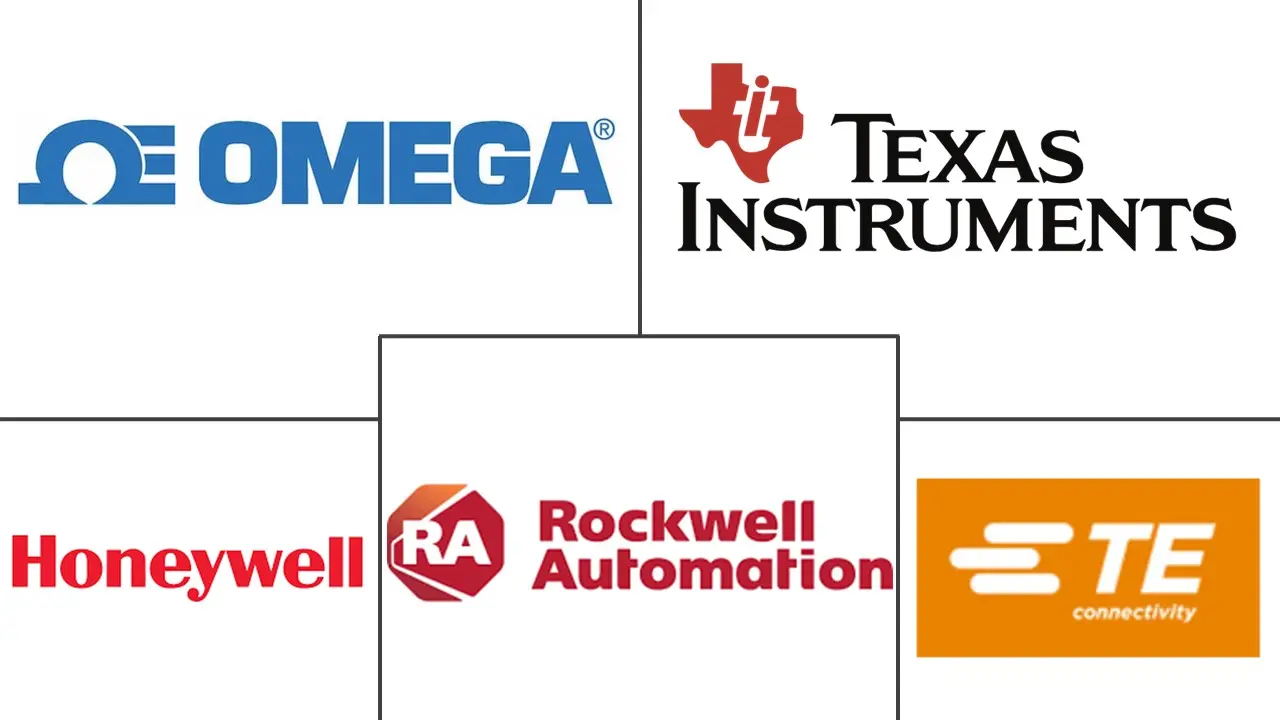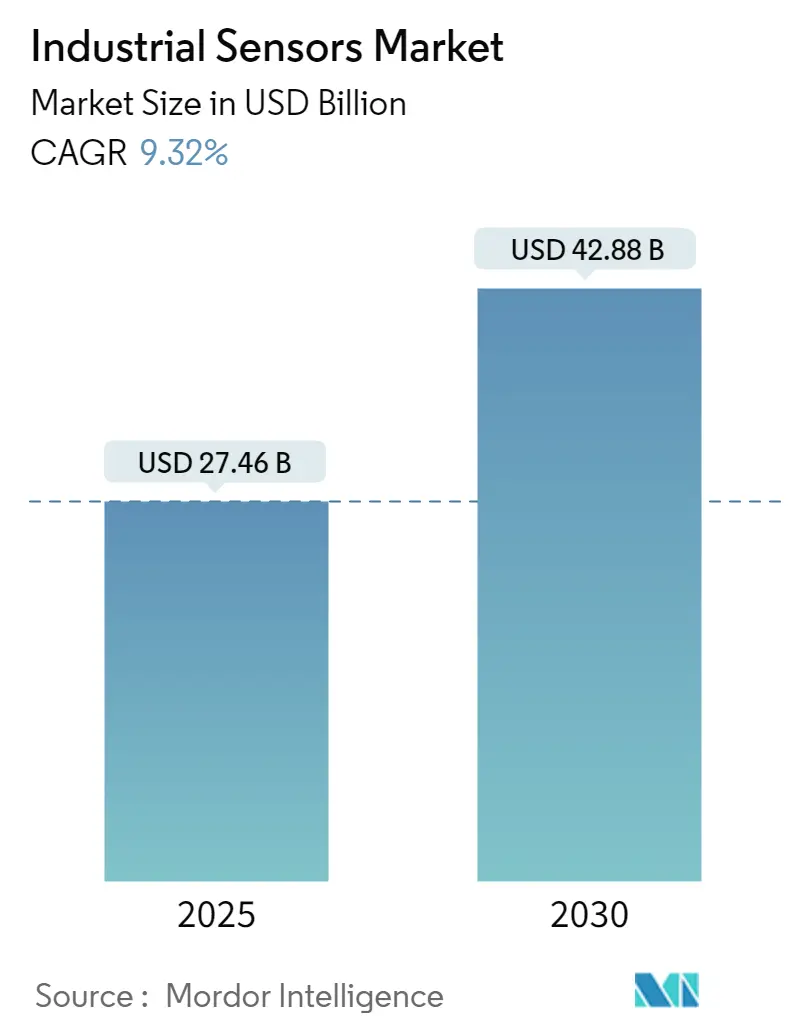
Industrial Sensors Market Analysis
The Industrial Sensors Market size is estimated at USD 27.46 billion in 2025, and is expected to reach USD 42.88 billion by 2030, at a CAGR of 9.32% during the forecast period (2025-2030).
The industrial sensors landscape is experiencing a significant transformation driven by the convergence of traditional manufacturing processes with advanced digital technologies. Industrial IoT sensors have enabled industries to fundamentally reimagine their business models, creating new revenue streams through data-sharing ecosystems and strategic partnerships. The integration of legacy machinery with IIoT platforms has become increasingly sophisticated, allowing for multiple use cases across different roles and applications. Manufacturers are leveraging these connected sensor networks to monitor asset uptime and performance metrics continuously, leading to more efficient and responsive production systems.
Technological advancement in sensor miniaturization and capability enhancement is reshaping industrial applications across sectors. Laser sensors have evolved to measure 3D motion and vibrations of any surface, enabling real-time monitoring of engines, turbines, and pumps. The development of compact and contactless form factors has made it possible for these sensors to function effectively in challenging environments, including hot, wet, and moving surfaces. This technological progression has particularly benefited the automotive sector, where MEMS pressure sensors have gained significant traction for smart automotive applications.
Raw material considerations and supply chain dynamics continue to play a crucial role in shaping the industrial sensors market. The manufacturing of high-quality temperature sensors relies heavily on specific metals and alloys, including platinum, copper, silicon, tungsten, nickel, and various specialized alloys categorized into different types. The selection of these materials significantly impacts sensor performance and reliability, making material sourcing and quality control critical aspects of sensor production. Manufacturers are increasingly focusing on developing eco-responsible and upgradeable sensor solutions that optimize resource utilization while maintaining high performance standards.
Industry-specific applications are driving specialized sensor development across various sectors. In the oil and gas industry, according to the International Energy Agency, US crude oil production is projected to reach 12.6 million barrels per day in 2023, necessitating advanced sensing solutions for monitoring and control. The automotive manufacturing sector has also witnessed significant developments, with the ASEAN Automotive Federation reporting that Indonesia and Thailand led production volumes in 2021, producing 887,202 and 754,254 motor vehicles respectively. These industry-specific demands are pushing sensor manufacturers to develop more specialized and sophisticated solutions that address unique operational requirements while ensuring reliability and precision.
Industrial Sensors Market Trends
Growing Adoption of IoT Leading to Demand for Sensing Components
The Industrial Internet of Things (IIoT) is fundamentally transforming manufacturing operations by enabling industries to develop new business models centered around data-sharing ecosystems and actionable insights. Industrial sensors integrated with IoT capabilities allow assets in heavy industrial operations to drive critical daily metrics, with manufacturers constantly monitoring the uptime of assets along their production lines. The consistent and reliable performance of these connected sensors has led to the development of robots and autonomous systems that can take specific actions based on real-time sensor data, particularly evident in warehouse operations through the Internet of Robotic Things (IoRT).
The integration of legacy machinery with industrial IoT platforms is driving significant innovation in industrial wireless sensors technologies. For instance, Endress+Hauser's Micropilot FWR30 cloud-connected radar system combines high-end 80 GHz wireless IIoT sensor technology with user-friendly digital services in a single cost-effective device, enabling transparency in the storage and transport of liquids. Similarly, VocalZoom's autonomous sensors for IIoT environments combine contactless vibration sensor technology with built-in data processing and wireless communications, offering low-cost and rapid deployment options for monitoring applications. These innovations demonstrate how sensor manufacturers are responding to industry demands for more intelligent, connected sensing solutions that can seamlessly integrate with IoT infrastructure.
Growing Emphasis on the Use of Predictive Maintenance and Remote Monitoring
The increasing focus on predictive maintenance sensors and remote monitoring capabilities is driving substantial innovations in industrial sensor technologies. Companies are developing sophisticated sensor solutions that enable preventive maintenance through continuous monitoring of equipment health and performance parameters. For instance, Asystom has introduced a range of multi-sensor IIoT devices featuring increased autonomy and on-board analytics capabilities, specifically designed to address predictive maintenance needs across various industrial equipment. These innovative products integrate new energy-saving electronics performing in-situ analysis, making them both eco-responsible and fully upgradeable for future requirements.
The implementation of remote monitoring solutions has become particularly crucial for industries requiring continuous operational oversight. A notable example is Hiber BV's partnership with Shell to provide well-integrity monitoring solutions globally, enabling more effective monitoring of well performance and integrity issues while improving the safety of remote and offshore wells. Similarly, Cisco has launched innovative IoT sensor solutions designed to simplify installations while offering enhanced security and scale, including the Meraki MT sensors for monitoring indoor environments and IT infrastructure. These solutions demonstrate how industrial automation sensors are evolving to provide comprehensive remote monitoring capabilities, helping improve efficiencies such as employee safety by preventing unnecessary site visits, reducing network outages and downtime, and minimizing costs associated with premature equipment failure.
Segment Analysis: By Sensor Type
Image Sensor Segment in Industrial Sensors Market
The image sensor segment continues to dominate the industrial sensors market, holding approximately 30% market share in 2024, representing a value of USD 26.77 billion. This significant market position is driven by the growing adoption of image sensors in various industrial applications, including quality inspection, automated optical inspection, and machine vision systems. The segment's leadership is further strengthened by the increasing implementation of Industry 4.0 initiatives across manufacturing sectors, where image sensors play a crucial role in enabling automated visual inspection and real-time monitoring capabilities. Additionally, the rising demand for high-resolution imaging in industrial processes and the integration of artificial intelligence with image sensing technologies have contributed to maintaining this segment's dominant position in the market.
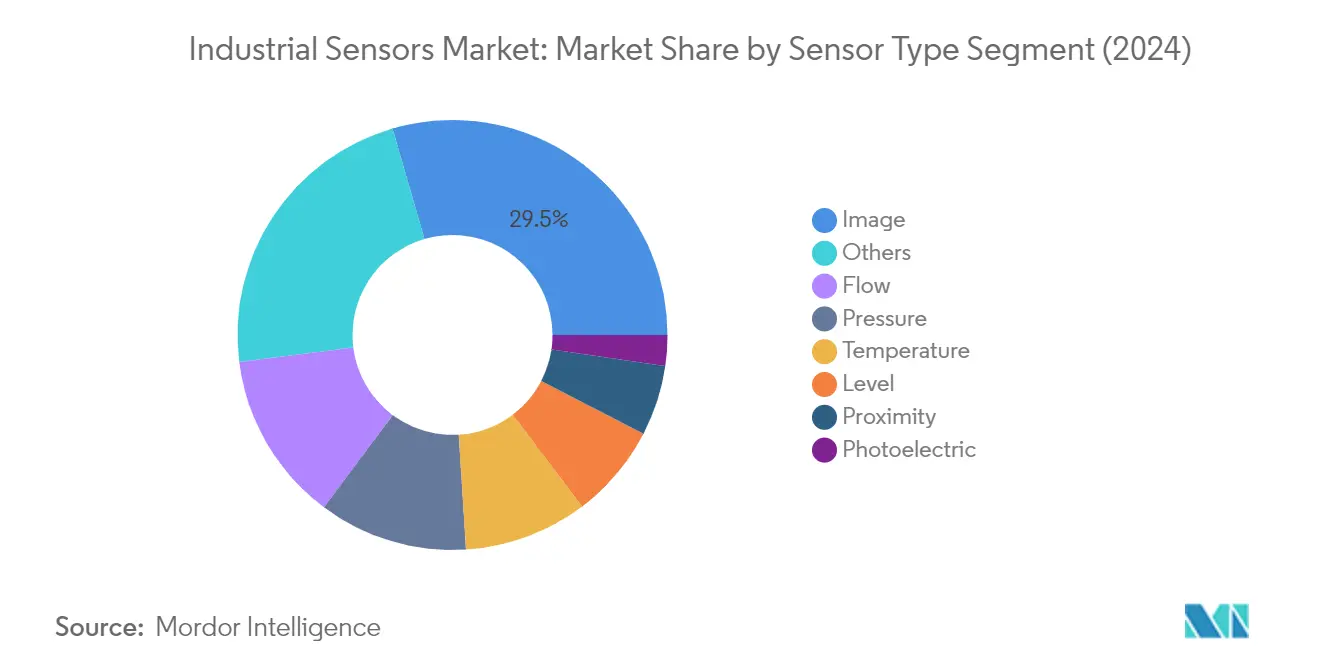
Flow Sensor Segment in Industrial Sensors Market
The flow sensor segment represents the second-largest category in the industrial sensors market, demonstrating robust growth potential from 2024 to 2029. These industrial flow sensors are witnessing increased adoption across critical industrial applications, particularly in chemical processing, water treatment, and oil & gas industries. The growth is primarily driven by the rising demand for precise flow measurement in industrial processes, enhanced focus on process optimization, and stringent regulatory requirements for flow monitoring in various industries. The segment's expansion is further supported by technological advancements in flow sensing technologies, including the development of non-invasive and highly accurate flow measurement solutions, along with the integration of smart capabilities and IoT connectivity features.
Remaining Segments in Industrial Sensors Market
The industrial sensors market encompasses several other significant segments, including industrial pressure sensors, level measurement sensors, industrial temperature sensors, proximity sensors, and photoelectric sensors. Industrial pressure sensors play a vital role in maintaining operational safety and efficiency across manufacturing processes, while industrial level sensors are crucial for inventory management and process control. Industrial temperature sensors continue to be fundamental in ensuring optimal operating conditions and product quality. Proximity sensors are essential for object detection and positioning in automated systems, while photoelectric sensors serve specific needs in detection and measurement applications. Each of these segments contributes uniquely to the overall market dynamics, driven by specific industrial applications and technological advancements in their respective domains.
Segment Analysis: By End-User Vertical
Chemical & Petrochemicals Segment in Industrial Sensors Market
The Chemical & Petrochemicals segment dominates the industrial sensors market, commanding approximately 30% market share in 2024. This segment's leadership position is driven by the stringent safety requirements and diverse range of processes that characterize petrochemical operations. The industry requires sensors for measuring temperatures ranging from cryogenic levels to over 800°C in cracking and sulfur recovery furnaces. Temperature, pressure, and flow sensors are extensively deployed across boilers, condensers, heat exchangers, cooling units, and diazotization vessels. The segment's dominance is further reinforced by strict regulatory compliance requirements related to toxic gas emissions and process control, making sensors indispensable for monitoring and maintaining safe operations in these high-risk environments.
Food & Beverage Segment in Industrial Sensors Market
The Food & Beverage segment is emerging as the fastest-growing vertical in the industrial sensors market, projected to expand at approximately 9% CAGR from 2024 to 2029. This remarkable growth is driven by increasing automation in food and beverage plants, stringent food safety regulations, and the rising demand for quality control in manufacturing processes. The segment is witnessing rapid adoption of advanced sensing technologies for monitoring critical parameters like temperature, pressure, and humidity throughout the production and storage processes. The integration of smart sensors with IoT capabilities is enabling real-time monitoring and predictive maintenance capabilities, particularly in areas such as cold chain management and production line optimization.
Remaining Segments in End-User Vertical
The industrial sensors market encompasses several other significant segments, including Mining & Metal, Power, Life Sciences, Aerospace & Military, and Water & Wastewater sectors. The Mining & Metal sector utilizes sensors for monitoring high-temperature processes and equipment safety, while the Power sector employs them for efficient power generation and distribution monitoring. Life Sciences applications focus on high-precision measurement and control in pharmaceutical manufacturing and research facilities. The Aerospace & Military segment emphasizes rugged and high-reliability sensors for critical applications, while the Water & Wastewater sector utilizes sensors for quality monitoring and process optimization in treatment facilities. Each of these segments contributes uniquely to the market's diversity and growth, driven by their specific technological requirements and regulatory standards.
Industrial Sensors Market Geography Segment Analysis
Industrial Sensors Market in North America
North America represents a mature industrial sensors market, characterized by advanced manufacturing capabilities and widespread adoption of Industry 4.0 technologies. The region's growth is primarily driven by the presence of major automotive manufacturers, aerospace industries, and a robust oil and gas sector. The United States and Canada are the key markets in this region, with both countries showing strong commitment to industrial automation sensors and digital transformation. The region benefits from extensive research and development activities, strong technical expertise, and the presence of major sensor manufacturers.
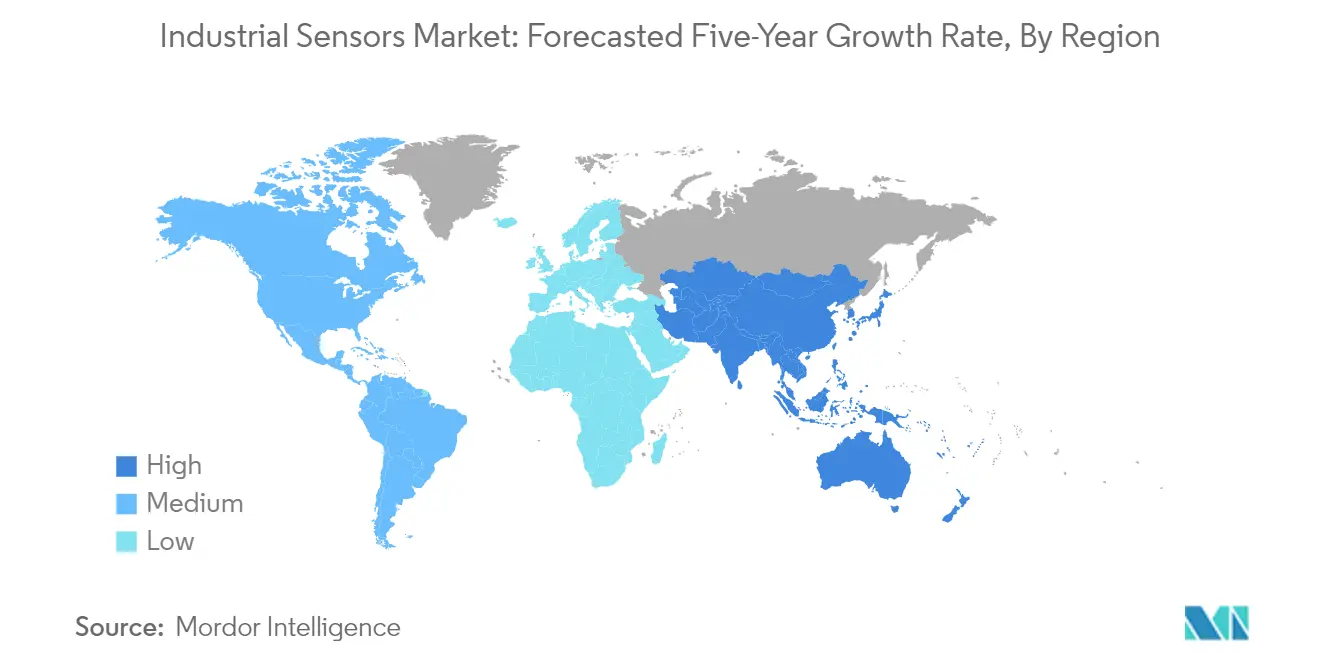
Industrial Sensors Market in United States
The United States dominates the North American industrial sensors market, accounting for approximately 75% of the region's market share in 2024. The country's market leadership is supported by its extensive manufacturing base, particularly in the automotive and aerospace sectors. The presence of major technology companies and their continuous investment in research and development has created a robust ecosystem for industrial sensors technologies. The US market is characterized by high adoption rates of advanced sensing technologies in various industries, including chemical, petrochemical, and food and beverage sectors. The country's focus on industrial control sensors and smart manufacturing initiatives continues to drive the demand for sophisticated sensing solutions.
Industrial Sensors Market in Canada
Canada emerges as the fastest-growing market in North America, with a projected growth rate of approximately 8% during 2024-2029. The country's growth is driven by increasing investments in industrial automation sensors and the strong presence of mining and oil & gas industries. Canada's commitment to environmental monitoring and sustainable industrial practices has led to increased adoption of advanced sensing technologies. The country's focus on developing smart manufacturing capabilities and the government's support for Industry 4.0 initiatives are creating new opportunities for factory automation sensors manufacturers. Canadian industries are increasingly implementing IoT-based solutions, driving the demand for connected sensors across various applications.
Industrial Sensors Market in Europe
Europe represents a sophisticated market for industrial sensors, with a strong emphasis on manufacturing automation and Industry 4.0 initiatives. The region's market is characterized by the presence of well-established automotive, aerospace, and chemical industries. Key countries, including Germany, France, and the United Kingdom, are driving innovation in sensor technologies through substantial investments in research and development. The region's strict industrial safety regulations and environmental standards have created a strong demand for advanced sensing solutions. The European market benefits from close collaboration between industry players, research institutions, and government bodies in developing next-generation sensor technologies.
Industrial Sensors Market in Germany
Germany maintains its position as the largest market for industrial sensors in Europe, holding approximately 25% of the region's market share in 2024. The country's leadership is attributed to its strong manufacturing base, particularly in the automotive and industrial machinery sectors. Germany's commitment to Industry 4.0 initiatives and the presence of major sensor manufacturers has created a robust ecosystem for sensor technology development. The country's focus on precision engineering and quality control in manufacturing processes continues to drive the demand for sophisticated sensing solutions. German industries are at the forefront of implementing smart factory concepts, creating sustained demand for advanced sensor technologies.
Industrial Sensors Market in France
France emerges as the fastest-growing market in Europe, with a projected growth rate of approximately 8% during 2024-2029. The country's growth is driven by increasing investments in industrial modernization and the strong presence of aerospace and automotive industries. France's commitment to digital transformation in manufacturing has created new opportunities for sensor technology deployment. The country's focus on developing smart cities and sustainable industrial practices is driving the adoption of advanced sensing solutions. French industries are increasingly implementing IoT-based monitoring systems, creating strong demand for connected sensor technologies.
Industrial Sensors Market in Asia-Pacific
The Asia-Pacific region represents a dynamic market for industrial sensors, driven by rapid industrialization and increasing adoption of automation technologies. The region encompasses major manufacturing hubs, including China, Japan, and South Korea, each contributing significantly to market growth. The rapid expansion of manufacturing facilities, particularly in the automotive, electronics, and consumer goods sectors, is creating strong demand for sensor technologies. The region's focus on smart manufacturing initiatives and Industry 4.0 adoption is driving innovation in sensor technologies.
Industrial Sensors Market in China
China stands as the largest market for industrial sensors in the Asia-Pacific region, driven by its extensive manufacturing base and aggressive adoption of automation technologies. The country's leadership is supported by strong government initiatives promoting smart manufacturing and Industry 4.0 adoption. China's robust automotive, electronics, and chemical industries create sustained demand for various types of sensors. The country's focus on developing domestic sensor manufacturing capabilities and reducing dependence on imports is reshaping the market dynamics.
Industrial Sensors Market in China
China also leads the growth trajectory in the Asia-Pacific region, supported by continuous investments in industrial modernization and automation. The country's rapid adoption of smart manufacturing technologies and IoT solutions is creating new opportunities for sensor deployments. Chinese industries are increasingly focusing on quality control and process optimization, driving demand for advanced sensing solutions. The government's support for technological innovation and industrial upgrading continues to fuel market growth.
Industrial Sensors Market in Latin America
The Latin American industrial sensors market is experiencing steady growth, driven by increasing industrialization and modernization of manufacturing facilities. The region's market is characterized by growing adoption of automation technologies in various industries, including automotive, food and beverage, and mining sectors. The focus on improving manufacturing efficiency and quality control is driving the demand for advanced sensing solutions. While the region faces economic challenges, investments in industrial automation and Industry 4.0 initiatives continue to create opportunities for sensor manufacturers. The market benefits from the presence of multinational manufacturing companies and their increasing focus on automation and process control.
Industrial Sensors Market in Middle East & Africa
The Middle East & Africa region presents growing opportunities in the industrial sensors market, primarily driven by investments in oil and gas, petrochemical, and manufacturing sectors. The region's market is characterized by an increasing focus on industrial automation and process control in key industries. Government initiatives promoting industrial diversification and modernization are creating new opportunities for sensor deployments. The adoption of advanced manufacturing technologies and the focus on improving operational efficiency are driving the demand for sophisticated sensing solutions. The market shows particular strength in applications related to oil and gas processing, water treatment, and industrial automation.
Industrial Sensors Industry Overview
Top Companies in Industrial Sensors Market
The industrial sensors market is characterized by continuous product innovation and technological advancement, with major players focusing on developing smart, connected sensor solutions aligned with Industry 4.0 sensors requirements. Companies are increasingly emphasizing the integration of IoT capabilities, artificial intelligence, and edge computing in their sensor portfolios to deliver enhanced value propositions. Strategic partnerships and collaborations, particularly between OT (Operations Technology) and IT (Information Technology) companies, have become crucial for expanding market reach and technological capabilities. Market leaders are demonstrating operational agility through investments in upskilling engineers for application-specific requirements and establishing robust distribution networks. Geographic expansion, particularly in high-growth regions like Asia-Pacific, coupled with the establishment of research and development centers, reflects the industry's commitment to innovation and market penetration.
Consolidated Market with Strong Global Players
The industrial sensors market exhibits a relatively consolidated structure dominated by large multinational corporations with diverse product portfolios and extensive geographic presence. These established players, including major technology conglomerates and specialized sensor manufacturers, leverage their strong research capabilities, manufacturing expertise, and established distribution networks to maintain market leadership. The market is characterized by a mix of vertically integrated companies that handle multiple stages of the value chain, from raw material processing to end-product manufacturing, and specialized players focusing on specific sensor technologies or applications.
The industry has witnessed significant merger and acquisition activity, driven by companies seeking to expand their technological capabilities, strengthen their market position, and enter new geographic markets. Strategic acquisitions are particularly focused on companies with innovative sensor technologies, specialized application expertise, or strong regional presence. Companies are also forming strategic alliances with software platform providers and system integrators to enhance their solution offerings and create comprehensive industrial automation sensors ecosystems.
Innovation and Integration Drive Market Success
Success in the industrial sensors market increasingly depends on companies' ability to develop integrated solutions that combine hardware, software, and services. Incumbent players are focusing on expanding their digital capabilities, investing in research and development for next-generation sensor technologies, and building strong relationships with end-users across various industrial sectors. The ability to provide customized solutions, ensure product reliability, and offer comprehensive after-sales support has become crucial for maintaining market position. Companies are also emphasizing the development of sensors with enhanced connectivity features, improved accuracy, and reduced power consumption to address evolving industrial requirements.
For new entrants and emerging players, success lies in identifying and focusing on specific market niches, developing innovative sensor technologies, and building strong partnerships with established players in the industrial automation ecosystem. The market presents opportunities for companies that can address specific industry challenges, such as harsh operating environments or specialized application requirements. However, companies must navigate challenges including high customer concentration in certain industrial sectors, increasing competition from alternative sensing technologies, and evolving regulatory requirements related to industrial safety and environmental protection. Building strong technical capabilities, establishing reliable supply chains, and developing effective go-to-market strategies are essential for gaining market share.
Industrial Sensors Market Leaders
-
Texas Instruments Incorporated
-
TE Connectivity Inc.
-
Omega Engineering Inc.
-
Honeywell International Inc.
-
Rockwell Automation Inc.
- *Disclaimer: Major Players sorted in no particular order
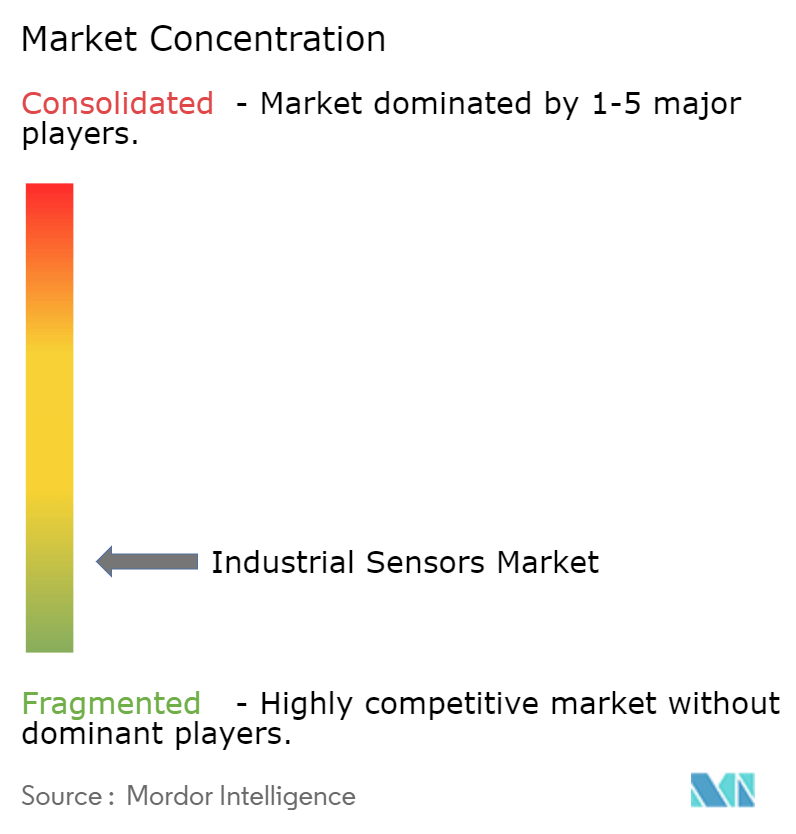
Industrial Sensors Market News
- July 2024: STMicroelectronics unveiled the VL53L4ED, a single-zone Time-of-Flight (ToF) sensor. With an impressive operating temperature range of -40°C to 105°C, this sensor is designed for demanding environments. The VL53L4ED enhances proximity detection and ranging capabilities, even under intense ambient light. Its versatile applications include industrial tools, smart factory machinery, robotic guidance systems, outdoor lighting management, and security solutions.
- June 2024: SICK has launched the Inspector83x 2D vision sensor, integrating Artificial Intelligence (AI) for rapid inspections on production lines. With the SICK Inspector83x, manufacturers can perform machine vision inspections with unmatched confidence and simplicity. The sensor ensures highly reliable outcomes, particularly in vital sectors such as consumer goods, food and beverage, automotive, and packaging.
Industrial Sensors Market Report - Table of Contents
1. INTRODUCTION
- 1.1 Study Assumptions and Market Definition
- 1.2 Scope of the Study
2. RESEARCH METHODOLOGY
3. EXECUTIVE SUMMARY
4. MARKET INSIGHTS
- 4.1 Market Overview
- 4.2 Industry Value Chain Analysis
-
4.3 Industry Attractiveness - Porter's Five Forces Analysis
- 4.3.1 Bargaining Power of Suppliers
- 4.3.2 Bargaining Power of Buyers
- 4.3.3 Threat of New Entrants
- 4.3.4 Threat of Substitute Products
- 4.3.5 Intensity of Competitive Rivalry
- 4.4 Impact of COVID-19 and Other Macroeconomic Factors on the Market
- 4.5 Technology Snapshot
5. MARKET DYNAMICS
-
5.1 Market Drivers
- 5.1.1 Growing Adoption of IoT Leading to Demand for Sensing Components
- 5.1.2 Growing Emphasis on the Use of Predictive Maintenance and Remote Monitoring
-
5.2 Market Restraints
- 5.2.1 Cost and Operational Concerns
6. MARKET SEGMENTATION
-
6.1 By Sensor Type
- 6.1.1 Flow
- 6.1.2 Pressure
- 6.1.3 Proximity (Area)
- 6.1.4 Level Measurement
- 6.1.5 Temperature
- 6.1.6 Image
- 6.1.7 Photoelectric
- 6.1.8 Other Sensing Types
-
6.2 By End User Vertical
- 6.2.1 Chemical and Petrochemicals
- 6.2.2 Mining and Metal
- 6.2.3 Power
- 6.2.4 Food and Beverage
- 6.2.5 Life Sciences
- 6.2.6 Aerospace and Military
- 6.2.7 Water and Wastewater
- 6.2.8 Other End-user Verticals
-
6.3 By Geography***
- 6.3.1 North America
- 6.3.1.1 United States
- 6.3.1.2 Canada
- 6.3.2 Europe
- 6.3.2.1 Germany
- 6.3.2.2 United Kingdom
- 6.3.2.3 France
- 6.3.3 Asia
- 6.3.3.1 China
- 6.3.3.2 Japan
- 6.3.3.3 South Korea
- 6.3.4 Australia and New Zealand
- 6.3.5 Latin America
- 6.3.6 Middle East and Africa
7. COMPETITIVE LANDSCAPE
-
7.1 Company Profiles
- 7.1.1 Texas Instruments Incorporated
- 7.1.2 TE Connectivity Inc.
- 7.1.3 Omega Engineering Inc.
- 7.1.4 Honeywell International Inc.
- 7.1.5 Rockwell Automation Inc.
- 7.1.6 Siemens AG
- 7.1.7 STMicroelectronics Inc.
- 7.1.8 ams AG
- 7.1.9 NXP Semiconductors NV
- 7.1.10 Infineon Technologies AG
- 7.1.11 Bosch Sensortec GmbH
- 7.1.12 Sick AG
- 7.1.13 ABB Limited
- 7.1.14 Omron Corporation
- *List Not Exhaustive
8. ANALYSIS OF LIMIT SWITCHES
- 8.1 Current Market Scenario
- 8.2 Market Dynamics
9. INVESTMENT ANALYSIS
10. MARKET OPPORTUNITIES AND FUTURE TRENDS
Industrial Sensors Industry Segmentation
The industrial sensors market is segmented by sensor type (flow, pressure, proximity (area, level measurement, temperature, image, photoelectric, other sensing type), by end-user vertical (chemical and pharmaceutical, mining and metal, power, food and beverages, life sciences, aerospace and military, and water and wastewater), and by geography (North America [United States, Canada], Europe [Germany, United Kingdom, France, Rest of Europe], Asia Pacific [China, Japan, South Korea, Rest of Asia Pacific], Latin America, Middle East and Africa). The report offers market forecasts and size in value (USD) for all the above segments.
| By Sensor Type | Flow | ||
| Pressure | |||
| Proximity (Area) | |||
| Level Measurement | |||
| Temperature | |||
| Image | |||
| Photoelectric | |||
| Other Sensing Types | |||
| By End User Vertical | Chemical and Petrochemicals | ||
| Mining and Metal | |||
| Power | |||
| Food and Beverage | |||
| Life Sciences | |||
| Aerospace and Military | |||
| Water and Wastewater | |||
| Other End-user Verticals | |||
| By Geography*** | North America | United States | |
| Canada | |||
| Europe | Germany | ||
| United Kingdom | |||
| France | |||
| Asia | China | ||
| Japan | |||
| South Korea | |||
| Australia and New Zealand | |||
| Latin America | |||
| Middle East and Africa | |||
Industrial Sensors Market Research FAQs
How big is the Industrial Sensors Market?
The Industrial Sensors Market size is expected to reach USD 27.46 billion in 2025 and grow at a CAGR of 9.32% to reach USD 42.88 billion by 2030.
What is the current Industrial Sensors Market size?
In 2025, the Industrial Sensors Market size is expected to reach USD 27.46 billion.
Who are the key players in Industrial Sensors Market?
Texas Instruments Incorporated, TE Connectivity Inc., Omega Engineering Inc., Honeywell International Inc. and Rockwell Automation Inc. are the major companies operating in the Industrial Sensors Market.
Which is the fastest growing region in Industrial Sensors Market?
Asia Pacific is estimated to grow at the highest CAGR over the forecast period (2025-2030).
Which region has the biggest share in Industrial Sensors Market?
In 2025, the Asia Pacific accounts for the largest market share in Industrial Sensors Market.
What years does this Industrial Sensors Market cover, and what was the market size in 2024?
In 2024, the Industrial Sensors Market size was estimated at USD 24.90 billion. The report covers the Industrial Sensors Market historical market size for years: 2019, 2020, 2021, 2022, 2023 and 2024. The report also forecasts the Industrial Sensors Market size for years: 2025, 2026, 2027, 2028, 2029 and 2030.
Our Best Selling Reports
Industrial Sensors Market Research
Mordor Intelligence provides a comprehensive analysis of the industrial sensors market. We leverage our extensive expertise in manufacturing sensors and industrial technology research. Our detailed report examines various sensor types, including industrial temperature sensors, industrial pressure sensors, industrial vibration sensors, and industrial proximity sensors. These insights are crucial for understanding their applications and technological advancements. The analysis also covers emerging trends in industrial IoT sensors and industrial wireless sensors. We focus particularly on predictive maintenance sensors and their role in modern manufacturing processes.
Stakeholders gain valuable insights through our report PDF, available for download. It covers the integration of industrial automation sensors and industrial control sensors across diverse applications. The research extensively analyzes the implementation of smart factory sensors and process control sensors in Industry 4.0 environments. Additionally, it examines innovations in industrial flow sensors, industrial gas sensors, and industrial level sensors. Our analysis is particularly beneficial for organizations implementing factory automation sensors and machine condition monitoring sensors. It provides strategic insights for the deployment of industrial safety sensors and the integration of industrial environmental sensors in modern manufacturing facilities.

